What is Ramen? It’s a steamy bowl of Japanese noodle soup celebrated for its rich flavors and enticing aroma. This culinary gem from Japan has captured the hearts of food enthusiasts worldwide with its savory broth and has become a staple on the global food stage.
More than just a comforting meal, ramen embodies a piece of Japanese culture. It appeals to both longtime fans and those new to its charms. Before you grab your chopsticks, let’s explore what makes ramen so special, from its flavorful broth to its perfectly cooked noodles.
The Origins of Ramen: A Journey from China to Japan
Ramen began its journey in the early 20th century on the bustling streets of Japan, drawing its initial inspiration from Chinese noodles. Though originally from China, it was the discerning tastes and culinary skills of the Japanese that transformed these humble noodles using alkaline-treated wheat flour, giving ramen its distinctive chewy texture and setting it apart from its Chinese ancestors.
The evolution of ramen continued with the accidental creation of Tonkotsu ramen in 1947. A forgotten pot left boiling for too long led to the development of a rich, velvety broth that quickly became a staple among ramen varieties, turning a simple mistake into a culinary masterpiece.
Post-World War II, ramen underwent another significant transformation, shifting from a luxury item to a popular street food. With an abundant supply of wheat flour from aid packages and a country in reconstruction, ramen became a symbol of resilience and recovery.
It transitioned from an upscale delicacy to an affordable everyday food, fueling Japan’s revival and becoming deeply ingrained in the nation’s cultural mosaic. This humble dish’s ability to adapt and evolve ensured its place as a central element of Japanese cuisine and a favorite comfort food around the world.
What Is Ramen: Deconstructing the Bowl
Let’s dive into the basics of ramen, a dish where every ingredient plays a key role in creating the rich flavors and textures we love. Here’s a simple breakdown of what goes into making this popular Japanese noodle soup.
Broth
The broth is the heart of any ramen bowl, setting the tone for the flavors to follow. You might find yourself sipping on a light chicken broth, a mixed pork and chicken broth, or the creamy richness of a pork-based tonkotsu broth. The key to a great broth is slow simmering, which brings out deep, complex flavors. The most authentic version, is when the broth is a rich, salty, pork flavor (like the color pictured above).
Noodles
No ramen is complete without crinkly looking noodles. They’re typically springy and slightly chewy, thanks to kansui, an alkaline mineral water that gives them their distinctive texture and color.
The right noodle can make or break your ramen experience, providing the perfect vehicle for enjoying the broth. For a more in-depth look at what goes into making ramen noodles, check out our article on “What Are Ramen Noodles Made Of?“
Tare Sauce
Tare is the concentrated essence that seasons the broth, essentially the soul of the dish. It can be soy sauce-based, salt-based, or miso-based, and its role is to infuse the broth with a deep, layered flavor that forms the backbone of the ramen’s identity.
Oil/Fat
To add richness and an aromatic touch to the ramen, a layer of oil or fat is often included. This can be anything from pork fat to sesame oil, enhancing the soup with additional flavor and a satisfying mouthfeel.
Toppings
Toppings are the grand finale, far from mere garnishes, they differentiate ramen from a simple noodle soup to a gourmet experience. Think of the perfectly soft-boiled eggs, delicate sheets of nori, and tender slices of fish cake and chashu pork. Other ancillary toppings may include corn, seaweed salad, and thinly sliced scallions.
Each topping is carefully selected to complement and contrast the underlying flavors and textures, turning it from a simple noodle soup to a full, balanced meal.
Ramen vs. Other Noodle Types: Udon, Pho, and Soba
Ramen, a beloved staple of Japanese cuisine, offers a unique culinary profile distinct from other popular noodles such as udon, pho, and soba. Here’s how they compare:
- Ramen vs. Udon: Ramen noodles are known for their thin, elastic texture, made from wheat flour mixed with kansui, which gives them their characteristic yellow color and springy quality. In contrast, udon noodles are much thicker and chewier, made from wheat flour, water, and salt, usually served in a mild dashi-based broth. Ramen’s diverse broth options, from miso to tonkotsu, allow for a richer and often meatier dining experience.
- Ramen vs. Pho: Moving to Vietnamese cuisine, pho noodles are made from rice flour, making them thinner and more delicate compared to ramen’s wheat-based strands. Pho is traditionally served in a clear broth, seasoned with spices and accompanied by fresh herbs, providing a lighter meal option compared to the often hearty and complex broths of ramen.
- Ramen vs. Soba: Soba noodles, made from buckwheat flour, offer a nutty taste and a grainier texture, which is a stark contrast to ramen’s smooth and elastic feel. Soba can be enjoyed hot or cold, often served with a dipping sauce or in a simple broth, which differs from the rich, flavorful broths typical of ramen dishes.
Each noodle type brings its own unique flavors and textures to the table, from ramen’s versatile and rich broths to udon’s satisfying chew, pho’s delicate simplicity, and soba’s earthy undertones.
Regional Ramens of Japan: A Tour of Flavors
Prepare your palate for a delightful ramble through Japan’s patchwork of noodle soups, a savory panorama of regional ramen varieties where locality speaks through every slurp. From the northern chills of Hokkaido to the southern warmth of Kyushu, every bowl is a testament to its origins, inviting you to savor its story, one spoonful at a time.
Hakata-Style: Fukuoka’s Rich Pork Legacy
In Fukuoka, the Hakata-style ramen reigns supreme. Its hallmark is a rich, milky tonkotsu broth, simmered to creamy perfection. Served with thin, firm noodles, this ramen harmonizes the robust flavors of pork with subtle accents of green onions and sesame seeds, creating a symphony of taste in every bowl.
Sapporo Miso Ramen: Hokkaido’s Creamy Creation
Now, don’t overlook the northern treasure that is Sapporo miso ramen. There’s a reason it’s a badge of pride for Hokkaido. Imagine a bowl brimming with a rich, miso-infused broth, where butter and corn aren’t just add-ons but essential cast members in a culinary drama that captivates with each bite.
Tokyo Shoyu Ramen: A Soy Sauce Delight
Tokyo’s take on ramen features a clear, soy sauce-based broth that’s both aromatic and flavorful. This lighter version is typically paired with curly noodles, tender slices of char siu pork, and a colorful array of toppings like bamboo shoots and boiled eggs.
Nagoya’s Spicy Red Miso Ramen
Not for the faint of heart, Nagoya’s version features a spicy red miso broth, packing a punch with bold flavors and a generous topping of minced pork, scallions, and spicy chili oil. It’s a vibrant dish that stands out for its intensity and depth.
Related Article: Now that you’re familiar with ramen, why not explore our guides on other Asian noodle dishes? Explore Japanese Udon and Vietnamese Pho to expand your culinary horizons.
Ramen Variations Amongst Different Cultures
No longer limited to its birthplace, ramen has burst onto the international stage, embraced by food lovers everywhere. This global popularity has sparked an era of ramen fusion, creatively blending traditional elements with local flavors in ways that even the most traditional ramen masters would appreciate.
| Country | Local Ingredients | Fusion Ramen Creation |
|---|---|---|
| Thailand | Lemongrass, Coconut, Chili | Tom Yum Goong Ramen |
| Italy | Pancetta, Pecorino Cheese, Black Pepper | Carbonara Ramen |
| Mexico | Chorizo, Avocado, Cilantro | Taco Ramen Bowl |
| United States | Smoked Brisket, Barbecue Sauce | Texas BBQ Ramen |
As these dishes suggest, ramen’s journey around the world is marked by creativity and a deep respect for its origins. This wonderful blend of tradition and innovation is more than just food; it’s a testament to the global love for Japan’s iconic noodle soup.
If you’re fascinated by how different cultures enjoy their noodle dishes, check out our article comparing Pho from Vietnam and Ramen.
FAQ
How is ramen different from other noodle soups?
Ramen is unique due to its rich, flavorful broths and the use of kansui (alkaline water) in the noodles, giving them a distinct texture and color. The detailed customization of toppings and flavor profiles also sets it apart from other noodle dishes.
Can ramen be considered healthy?
Ramen can vary in healthiness. Traditional ramen with fresh ingredients and less sodium can be a balanced meal. However, instant ramen is often high in sodium and preservatives, making it less healthy than freshly made ramen.
What is the best way to eat ramen?
The best way to enjoy ramen is to taste the broth before eating the noodles. In Japanese culture, slurping the noodles is not only acceptable but also encouraged, as it enhances the flavors and shows appreciation for the meal.
What are the main types of ramen broth?
The four main types of ramen broth are Shoyu (soy sauce), Miso (fermented soybean paste), Shio (salt), and Tonkotsu (pork bone).




